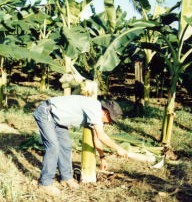If you have a superior variety of banana, and want to make it widely available, is there a shortcut or do you need to wait for pups to form naturally? Dr. Rowe shared a method that captured the attention of many at the conference.
“This is the most practical way known to increase the numbers of plants. In fields specifically for production of more planting material, the initial individual plants should be planted at a spacing of 2 x 2 meters (6.3 x 6.3 ft) as compared to a spacing of about 3.5 2 x 3.5 meters (8.9 x 11.4 ft) in fields for fruit production.”
The sequential procedures are illustrated with photos as follows.







All the suckers (Step 7) should be dug and the corms prepared by cutting the trunks off at about (5.1 x 7.6 cm) (2-3 in) above the corms. Roots should be removed by cutting them off at the surface of the corms. Corms 10.1 cm (4 in) and larger in diameter can be planted directly in the field. Smaller corms can be allowed to grow 3-4 months in plastic bags (with a soil capacity of about 2 liters) before being planted in the field.
For additional multiplications, replant the largest corm in the spot from which the corms were dug. Then, after the plant from this corm is about the size shown in Step 1, the multiplication process can be repeated.
The method works because the apical dominance of the growing point has been destroyed by the stake driven through the middle of the stem.
Cite as:
ECHO Staff 1999. Rapid Multiplication of Banana Plants in the Field. ECHO Development Notes no. 66